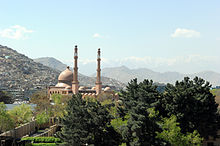This article may require cleanup to meet Wikipedia's quality standards. The specific problem is: Too many bullet points like a list, instead of sentences and paragraphs. Also needs better organization between 'Staple foods', 'Drinks' etc. Needs more encyclopedic content instead of current catalog-like format. (November 2021) |
| Part of a series on the |
| Culture of Afghanistan |
|---|
 |
| History |
| People |
| Languages |
| Mythology |
| Cuisine |
| Festivals |
| Religion |
| Sport |
Afghan cuisine is influenced by Persian, Central Asian, and South Asian cuisines due to Afghanistan's close proximity and cultural ties.[1][2] The cuisine is halal and mainly based on mutton, beef, poultry and fish with rice and Afghan bread. Accompanying these are common vegetables and dairy products, such as milk, yogurt, whey,[3] and fresh and dried fruits such as apples, apricots, grapes, bananas, oranges, plums, pomegranates, sweet melons, and raisins.[4] The diet of most Afghans revolves around rice-based dishes, while various forms of naan are consumed with most meals.[5] Tea is generally consumed daily in large quantities, and is a major part of hospitality.[6] The culinary specialties reflect the nation's ethnic and geographic diversity. The national dish of Afghanistan is Kabuli palaw, a rice dish cooked with raisins, carrots, nuts, and lamb or beef.[7]
- ^ Cite error: The named reference
Woodswas invoked but never defined (see the help page). - ^ "About Afghan food". SBS. 31 March 2021. Archived from the original on 12 November 2021. Retrieved 13 November 2021.
- ^ Brittin, Helen (2011). The Food and Culture Around the World Handbook. Boston: Prentice Hall. pp. 20–21. ISBN 9780135074817.
- ^ "Rare Heirloom Seeds – Baker Creek Heirloom Seeds". Baker Creek Heirloom Seeds. Archived from the original on 2016-03-04. Retrieved 2013-10-28.
- ^ "What to eat and drink in Afghanistan". Archived from the original on 2021-11-29. Retrieved 2021-11-29.
- ^ "Sheer Chai Afghan (Cardamom Tea with milk)". July 2020. Archived from the original on 2021-11-29. Retrieved 2021-11-29.
- ^ Cite error: The named reference
food republicwas invoked but never defined (see the help page).